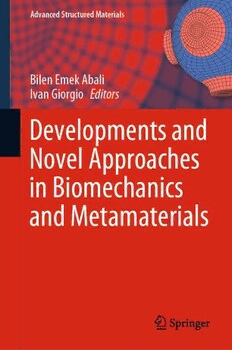
Developments and Novel Approaches in Biomechanics and Metamaterials PDF
Preview Developments and Novel Approaches in Biomechanics and Metamaterials
Advanced Structured Materials Bilen Emek Abali Ivan Giorgio Editors Developments and Novel Approaches in Biomechanics and Metamaterials Advanced Structured Materials Volume 132 Series Editors Andreas Öchsner, Faculty of Mechanical Engineering, Esslingen University of Applied Sciences, Esslingen, Germany Lucas F. M. da Silva, Department of Mechanical Engineering, Faculty of Engineering, University of Porto, Porto, Portugal Holm Altenbach , Faculty of Mechanical Engineering, Otto von Guericke University Magdeburg, Magdeburg, Sachsen-Anhalt, Germany Common engineering materials reach in many applications their limits and new developments are required to fulfil increasing demands on engineering materials. The performance ofmaterials can beincreasedby combiningdifferent materials to achieve better properties than a single constituent or by shaping the material or constituents in a specific structure. The interaction between material and structure mayariseondifferentlengthscales,suchasmicro-,meso-ormacroscale,andoffers possible applications in quite diverse fields. Thisbookseriesaddressesthefundamentalrelationshipbetweenmaterialsandtheir structure on the overall properties (e.g. mechanical, thermal, chemical or magnetic etc.) and applications. The topics of Advanced Structured Materials include but are not limited to (cid:129) classical fibre-reinforced composites (e.g. glass, carbon or Aramid reinforced plastics) (cid:129) metal matrix composites (MMCs) (cid:129) micro porous composites (cid:129) micro channel materials (cid:129) multilayered materials (cid:129) cellular materials (e.g., metallic or polymer foams, sponges, hollow sphere structures) (cid:129) porous materials (cid:129) truss structures (cid:129) nanocomposite materials (cid:129) biomaterials (cid:129) nanoporous metals (cid:129) concrete (cid:129) coated materials (cid:129) smart materials Advanced Structured Materials is indexed in Google Scholar and Scopus. More information about this series at http://www.springer.com/series/8611 Bilen Emek Abali Ivan Giorgio (cid:129) Editors Developments and Novel Approaches in Biomechanics and Metamaterials 123 Editors Bilen EmekAbali IvanGiorgio Institute of Mechanics Department ofMechanical Technische UniversitätBerlin andAerospace Engineering Berlin, Germany University of RomeLa Sapienza Latina, Italy ISSN 1869-8433 ISSN 1869-8441 (electronic) AdvancedStructured Materials ISBN978-3-030-50463-2 ISBN978-3-030-50464-9 (eBook) https://doi.org/10.1007/978-3-030-50464-9 ©SpringerNatureSwitzerlandAG2020 Thisworkissubjecttocopyright.AllrightsarereservedbythePublisher,whetherthewholeorpart of the material is concerned, specifically the rights of translation, reprinting, reuse of illustrations, recitation, broadcasting, reproduction on microfilms or in any other physical way, and transmission orinformationstorageandretrieval,electronicadaptation,computersoftware,orbysimilarordissimilar methodologynowknownorhereafterdeveloped. The use of general descriptive names, registered names, trademarks, service marks, etc. in this publicationdoesnotimply,evenintheabsenceofaspecificstatement,thatsuchnamesareexemptfrom therelevantprotectivelawsandregulationsandthereforefreeforgeneraluse. The publisher, the authors and the editors are safe to assume that the advice and information in this book are believed to be true and accurate at the date of publication. Neither the publisher nor the authors or the editors give a warranty, expressed or implied, with respect to the material contained hereinorforanyerrorsoromissionsthatmayhavebeenmade.Thepublisherremainsneutralwithregard tojurisdictionalclaimsinpublishedmapsandinstitutionalaffiliations. ThisSpringerimprintispublishedbytheregisteredcompanySpringerNatureSwitzerlandAG Theregisteredcompanyaddressis:Gewerbestrasse11,6330Cham,Switzerland Preface TheICoNSOM2019,InternationalConferenceonNonlinearSolidMechanics,took placeatPalazzoArgiletum,Rome,Italy,fromJune16toJune19,2019.Over200 participationfromthewholeglobe,theurgeofthisproceedingsbecameclear.With theaidoftheorganizers,MarcoAmabili,Francescodell’Isola,IvanGiorgio,Nicola Rizzi,andLucaPlacidi,thescientificcommunitydidshowagreatinterestallowing ustobringtogetherthisproceedingscollectedintwovolumes: • DevelopmentsandNovelApproachesinNonlinearSolidBodyMechanics • DevelopmentsandNovelApproachesinBiomechanicsandMetamaterials ICoNSoM 2019 Conference has been intended to provide an international oppor- tunity for communicating recent developments in various areas of nonlinear solid mechanics. This monograph consists theory, experiments, and applications in me- chanics,thermodynamics,andmultiphysicssimulationinmanylengthscales. Aseditors,weintendtothankallauthorsfortheircrucialcontributionsaswell asallreviewersfortheirinvaluabletimeandeffort.WedelightedlyacknowledgeDr. ChristophBaumann(SpringerPublisher)forinitiatingthebookproject.Inaddition, wehavetothankDr.MayraCastro(SeniorEditorAppliedSciences;MaterialsSci- ence; Materials Engineering; Nanotechnology and Nanomedicine) and Mr. Ashok Arumairaj(ProductionAdministrator)givingtheirsupportintheprocessofpubli- cation. Brussels,Rome BilenEmekAbali May2020 IvanGiorgio v Contents 1 PerspectivesinGeneralizedContinua........................... 1 MarcoLaudato&AlessandroCiallella 1.1 Introduction.............................................. 1 1.2 PerspectivesinGeneralizedContinua......................... 2 1.2.1 J-, M-, and L-integrals: from Micromechanics of Dislocations to Body Charges and Forces - Eleni Agiasofitou....................................... 3 1.2.2 Non-conventionalBehaviorofHighlyContrastedPlates -TheoryandExperiments-ClaudeBoutin ............ 3 1.2.3 PantographicMetamaterials-Francescodell’Isola...... 4 1.2.4 ConvectedStressandBalanceEquations-Salvatore Federico ......................................... 4 1.2.5 Singularity-freePointofDefects:GradientElasticityof Bi-HelmholtzType-MarkusLazar................... 5 1.2.6 InfluenceofRandomnessinTopologyandGeometry ontheStiffnessofDifferentNetworksGeneratedfrom theSameGraph-UweMühlich ..................... 5 1.2.7 HomogenizationofMetamaterialswithStrainGradient EffectsBasedonAsymptoticAnalysis-HuaYang...... 6 1.2.8 ExperimentsPerformedonAdditivelyManufactured PantographicStructures,ValidatedbyDigitalImage Correlation-GregorGanzosch ...................... 6 1.2.9 Dynamicsof2DPantographicMetamaterial:Numerical andExperimentalResults-MarcoLaudato ............ 7 1.2.10 PivotsDamageMechanisminMetallicPantographic Structures:AnOverview-MarioSpagnuolo........... 7 1.3 Conclusions.............................................. 8 References ..................................................... 8 PartI Biomechanics vii viii Contents 2 FailurePredictionofTumoralBonewithOsteolyticLesioninMice.. 17 BenjaminDelpuech,StéphaneNicolle,CyrilleB.Confavreux,Lamia Bouazza,PhilippeClezardin,DavidMitton,andHélèneFollet 2.1 Introduction.............................................. 18 2.2 MaterialandMethods ..................................... 19 2.2.1 Tumorigenesis .................................... 19 2.2.2 RheologicalTestsonTumorandSoftTissues .......... 20 2.2.3 Intra-tibialBoneMetastases......................... 21 2.2.4 Imaging:μCTAcquisitionandReconstruction ......... 21 2.2.5 CompressionTestsonTibia ......................... 22 2.2.6 FEModelCreation ................................ 22 2.2.7 FEASpecifications ................................ 24 2.2.8 MeshElementSizeConvergenceStudy ............... 24 2.2.9 FailureCriterionParametersDetermination............ 25 2.2.10 RegionsofInterestforFailureAssessment............. 25 2.2.11 StatisticalAnalysis ................................ 25 2.3 Results .................................................. 26 2.3.1 RheologicalResults................................ 26 2.3.2 ShamandControlLimbsComparison ................ 26 2.3.3 MeshElementSizeConvergenceStudy ............... 26 2.3.4 ResultsforHeterogeneousModels ................... 26 2.3.5 SpecificModelResults ............................. 28 2.3.6 GlobalandLocalAnalysis .......................... 28 2.4 Discussion ............................................... 31 2.5 Conclusion............................................... 32 References ..................................................... 32 3 Automatic Classification of Intramuscular EMG to Recognize Pathologies................................................. 35 AlbanGallard,KonstantinAkhmadeev,EricLeCarpentier,Raphaël Gross,YannPéréon,andYannickAoustin 3.1 Introduction.............................................. 36 3.2 Methods................................................. 38 3.2.1 Data............................................. 38 3.2.1.1 Preprocessing............................ 38 3.2.1.2 Decomposition .......................... 39 3.2.2 Motorunit(MU) .................................. 40 3.2.3 Pathologies....................................... 40 3.2.4 Features ......................................... 41 3.2.5 Classification ..................................... 42 3.2.5.1 LinearSVM............................. 43 3.2.5.2 BaggingTrees ........................... 43 3.3 Results .................................................. 44 3.4 Discussion ............................................... 45 3.5 Conclusion............................................... 46 Contents ix References ..................................................... 47 4 AlgorithmicFormulationofBoneFabricEvolutionBasedonthe DissipationPrinciple:A2DFinite-ElementStudy ................ 49 MadgeMartin,PeterPivonka,GuillaumeHaïat,ThibaultLemaire,and VittorioSansalone 4.1 Introduction.............................................. 50 4.2 MaterialsandMethods..................................... 54 4.2.1 KinematicsandRemodelingLaw .................... 54 4.2.2 NumericalSolution................................ 55 FEMeshandRemodelingGrid............. 55 BoundaryValueProblem.................. 55 UpdatingMicro-Orientation ............... 56 ExitCriterion............................ 58 4.3 ResultsandDiscussion..................................... 58 4.3.1 MeshingStrategy.................................. 59 4.3.2 QuadratureofMicro-RotationRate................... 61 4.3.3 Geometry ........................................ 63 4.3.4 MaterialProperties ................................ 64 4.4 Conclusion............................................... 65 References ..................................................... 67 5 Data-DrivenSimulationforAugmentedSurgery ................. 71 Andrea Mendizabal, Eleonora Tagliabue, Tristan Hoellinger, Jean-NicolasBrunet,SergeiNikolaev,andStéphaneCotin 5.1 Introduction.............................................. 72 5.2 NumericalSimulationofHyperelasticityProblems ............. 74 5.2.1 HyperelasticityofSoftTissues ...................... 74 5.2.2 FiniteElementMethod............................. 75 5.3 StochasticIdentificationofPatient-SpecificProperties .......... 76 5.3.1 ROUKF:OverviewoftheAlgorithm ................. 77 5.3.2 EstimationoftheYoung’sModulusUsingKalmanFilters 78 5.3.3 Estimation of Boundary Conditions Using Kalman Filters ........................................... 79 5.4 DeepNeuralNetworksforData-DrivenSimulationsofaLiver ... 81 5.4.1 Method .......................................... 82 5.4.1.1 TheU-MeshFramework .................. 82 5.4.1.2 SyntheticDataGenerationforU-NetTraining. 83 5.4.1.3 ValidationMetrics........................ 84 5.4.2 PredictingtheDeformationoftheLiver ............... 84 5.4.2.1 U-MeshonaSyntheticLiver............... 85 5.4.2.2 U-MeshforAugmentedHepaticSurgery..... 86 5.5 UpdatingtheTrainedModelThroughTransferLearning......... 88 5.5.1 BeamwithHiddenFixedDirichletBCs ............... 89 5.5.2 NewBoundaryConditionsandSparseData............ 91 5.6 Conclusion............................................... 92 x Contents References ..................................................... 94 6 New Aspects of the Trabecular Bone Remodeling Regulatory Model—TwoPostulatesBasedonShapeOptimizationStudies ...... 97 MichałNowak 6.1 Introduction.............................................. 97 6.2 TheStiffestDesignProblem ................................ 98 6.3 TheModificationoftheStructuralSurfacePosition—Mimicking theRemodelingProcess....................................100 6.4 TheProblemofMultiple-LoadConditions ....................102 6.5 Conclusions..............................................104 References .....................................................104 7 BoneMechanicsandCellPopulations:MathematicalDescription andParametricStudyoftheModel ............................ 107 AlessioCiroRapisarda,MatinAlmasi,NaserAlmasi,EmilioBarchiesi, AlessandroDellaCorte,andDariaScerrato 7.1 Introduction..............................................108 7.2 TheModel...............................................108 7.2.1 TheStimulusFunction .............................110 7.2.2 TheMechanicalEquations..........................111 7.3 EstimateoftheModel’sParameters ..........................112 7.3.1 EstimateofInitialDataandRemoval/ProductionRates oftheCells.......................................112 7.3.2 Estimate of the Differentiation Rates and Coupling Coefficients ......................................115 7.4 NumericalSimulations.....................................117 7.5 SummaryoftheResults....................................121 7.6 Conclusions..............................................121 References .....................................................122 8 Non-Linear or Quasi-Linear Viscoelastic Property of Blood for HemodynamicSimulations ................................... 127 ErnestoRomano,LuísaC.Sousa,CarlosC.António,CatarinaF.Castro, andSóniaIsabelSilvaPinto 8.1 Introduction..............................................128 8.2 MaterialsandMethods.....................................130 8.2.1 MathematicalModelsforBloodRheology.............130 8.2.2 ImplementationoftheViscoelasticModels ............132 8.2.3 3DGeometryandComputationalMesh ...............133 8.2.4 BoundaryConditions ..............................134 8.2.5 NumericalMethod ................................135 8.3 ResultsandDiscussion.....................................135 8.4 Conclusion...............................................137 References .....................................................138
